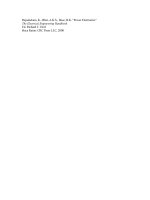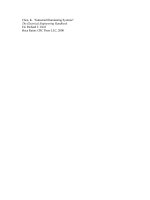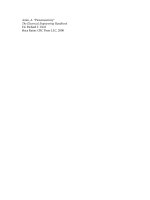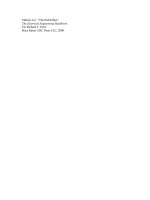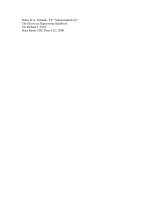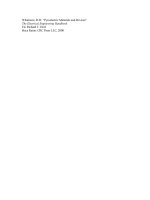Lecture Electrical Engineering: Lecture 32 - Dr. Nasim Zafar
Bạn đang xem bản rút gọn của tài liệu. Xem và tải ngay bản đầy đủ của tài liệu tại đây (1.24 MB, 65 trang )
COMSATS Institute of Information Technology
Virtual campus
Islamabad
Dr. Nasim Zafar
Electronics 1 EEE 231
Fall Semester – 2012
Summary
9/24/18
Dr. Nasim Zafar.
2
Lecture No. 32
v
Contents:
Ø
Introduction to Semiconductor Materials
Ø
Summary of Basic semiconductor devices
Ø
Basics of IC processing
9/24/18
Dr. Nasim Zafar.
3
References
Ø Microelectronic Circuits:
Adel S. Sedra and Kenneth C. Smith.
Ø
Electronic Devices :
Thomas L. Floyd ( Prentice Hall ).
Ø Integrated Electronics
Jacob Millman and Christos Halkias (McGrawHill).
Ø
9/24/18
Electronic Devices and Circuit Theory:
Robert Boylestad & Louis Nashelsky ( Prentice Hall ).
Dr. Nasim Zafar.
4
Introduction
v
Ø
Ø
From Discrete to Integrated!
In 1954, Texas Instruments produced the first
commercial silicon transistor.
Before the invention of the integrated circuits,
electronic equipment was composed of discrete
components such as transistors, resistors, and
capacitors. These components, often simply called
“discrete”, were manufactured separately and were
wired or soldered together onto circuit boards.
9/24/18
Dr. Nasim Zafar
5
Active Electronic Components
v
v
An active electronic component either amplifies or
switches.
–
The most common active components are diodes and
transistors.
–
Both diodes and transistors are easy to make with
semiconductors.
With semiconductor materials, it is possible to create
complete circuits of active and/or passive components
wired together.
9/24/18
Dr. Nasim Zafar.
6
Integrated Circuits
Ø
Ø
Ø
Integrated circuits (ICs) are
semiconductor devices that
are complete circuits made up
of transistors, diodes,
capacitors, resistors and
inductors.
The complete circuit is made
on a single piece of silicon
called a chip.
Any circuit from a simple
amplifier to a quad core
microprocessor used in a PC
can be made.
Dr. Nasim Zafar.
7
Introduction to Semiconductor Materials
v
v
Semiconductors are the materials with conductivity between
conductor and insulator.
Its conductivity can be controlled by dopant concentration and
applied voltage.
v
Elemental Semiconductors: Silicon and Germanium.
v
Compound Semiconductors:
–
SiGe, SiC
–
GaAs, InP, etc..
9/24/18
Dr. Nasim Zafar.
8
Introduction to Semiconductor Materials
v
v
v
v
Boron doped semiconductor is ptype, majority carriers are
holes.
P, As, or Sb doped semiconductor is ntype, the majority
carriers are electrons.
Higher dopant concentration, lower resistivity.
At the same dopant concentration, ntype has lower
resistivity than ptype.
9/24/18
Dr. Nasim Zafar.
9
Energy Band Structure of an Atom
Valence shells
Nuclei
Conducting band, Ec
Band gap, Eg
Valence band, Ev
9/24/18
Dr. Nasim Zafar.
10
Energy Bands and Band Gap in Solids
Eg = 1.1 eV
Eg = 8 eV
Aluminum
Sodium
Silicon
Silicon dioxide
2.7 µΩ cm
4.7 µΩ cm
~ 1010 µΩ cm
> 1020 µΩ cm
Conductors
9/24/18
Semiconductor
Dr. Nasim Zafar.
Insulator
11
Carrier Concentration and Mobility
v
Higher dopant concentration, more carriers: electrons or
holes.
v
Electron mobility higher than holes.
v
Higher conductivity, lower resistivity.
v
Ntype silicon has lower resistivity than ptype silicon at the
same dopant concentration.
9/24/18
Dr. Nasim Zafar.
12
Silicon
Ø
Abundant, inexpensive
Ø
Thermal stability
Ø
Silicon dioxide is a strong dielectric and relatively
easy to form
Ø
9/24/18
Silicon dioxide can be used as diffusion doping mask
Dr. Nasim Zafar.
13
SummarySemiconductor Materials
v
Semiconductor Materials:
• Elemental semiconductors
• Intrinsic and Extrinsic Semiconductor
• Compound semiconductors
III – V Gap, GaAs
II – V e.g ZnS, CdTe
• Mixed or Tertiary Compounds
e.g. GaAsP
9/24/18
v
Applications:
Dr. Nasim Zafar.
14
Summary of Semiconductor Devices
9/24/18
Dr. Nasim Zafar.
15
Summary of Semiconductor Devices
v
v
Diodes, BJTs and FETs are nonlinear devices made of
semiconductors, mostly silicon.
Diodes:
–
A diode allows current to flow in the forward direction and
hence can perform functions such as rectification,
demodulation/detection, switch etc.
–
The reverse current may become dramatically large at
breakdown, such phenomena can be used as voltage
regulator .
9/24/18
Dr. Nasim Zafar.
16
Summary of Semiconductor Devices
v
Bipolar Junction Transistors:
Ø
A BJT has three terminals: base, emitter and collector.
Ø
The collector current is controlled by voltage/ current on the
baseemitter junction and is almost independent on collector
voltage.
Ø
It can perform functions such as amplification and switch, etc.
Ø
A BJT should be properly biased for normal operation.
There are three basic configurations, each has different.
performance (input/output resistance, gain, high frequency
response, etc.). Dr. Nasim Zafar.
9/24/18
17
Ø
Basic Devices:
9/24/18
v
Diode: PN Junction
v
Bipolar Junction Transistor: BJT
v
MOS Transistor
Dr. Nasim Zafar.
18
The Diode
Anode
9/24/18
Dr. Nasim Zafar.
Cathode
19
The Diode
PN Junction Diode Schematic Symbol:
Anode
Cathode
p
9/24/18
Dr. Nasim Zafar.
n
20
Biasing a PN Junction
Ø
Ø
Ø
Ø
Ø
For current flow in a PN junction
or diode, we have to apply an
external voltage called Bias.
With this connection, current only
flows freely from cathode across
the junction to the anode.
we’d say the switch is closed when
electrons can flow through the
diode.
Note: The current flow may be so
high that an external resistance R is
usually needed to minimize the
current flow to a level a diode can
withstand.
This arrangement is called forward
bias.
Dr. Nasim Zafar.
21
ForwardBiased Diode Circuit
R
R
I F > 0A
I F > 0A
IF
V
IF
V
+V
-V
R
R
IF
9/24/18
Dr. Nasim Zafar.
IF
22
ReverseBiased Diode Circuit
R
R
0A
0A
IT
IT
V
V
+V
-V
R
9/24/18
R
Dr. Nasim Zafar.
23
Diode IV characteristics
VoltageCurrent relationship for a pn junction (diode)
9/24/18
Dr. Nasim Zafar.
24
Complete: Model Diode Curve
IF(mA)
100
IR
VZ
80
VR(V)
80
Reverse operating
region (also called
the reverse
breakdown
region)
60
Forward
operating
region
60
RZ
RZ
Complete model
Accurate model
40
VR
IR
20
40
20
0.2
0.4
0.6
VF(V)
0.8
1.0
I=0
IF
0.7 V
2.0
RB
3.0
RB
9/24/18
IR( A)
Dr. Nasim Zafar.
25
VF
IF
